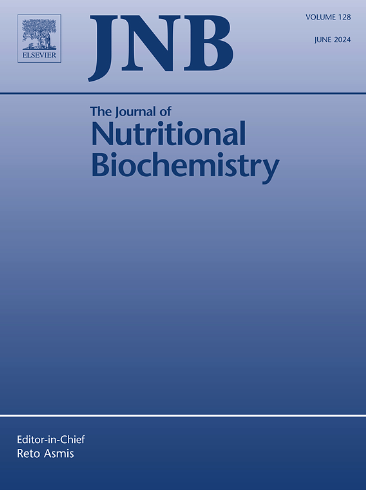Ginsenoside Rg1 alleviated experimental colitis in obesity mice by regulating memory follicular T cells via Bcl-6/Blimp-1 pathway
IF 4.8
2区 医学
Q1 BIOCHEMISTRY & MOLECULAR BIOLOGY
引用次数: 0
Abstract
The pathological mechanisms of ulcerative colitis (UC) are closely related with abnormal memory follicular helper T (mTfh) cell subsets and the Bcl-6/Blimp-1 signaling pathway. Ginsenoside Rg1 (G-Rg1) has been confirmed to exhibit therapeutic effects in obese mice with dextran sulfate sodium (DSS)-induced ulcerative colitis. The aim of this study was to investigate the mechanism of action of G-Rg1 in obese mice with UC by observing mTfh cell subsets and the Bcl-6/Blimp-1 signaling pathway. Obese mice with UC were treated with G-Rg1 at a dose of 200 mg/kg. Disease activity was assessed macroscopically and microscopically, and cytokine levels were measured using enzyme-linked immunosorbent assay (ELISA). Flow cytometry was employed to analyze mTfh cell subsets, and Western blotting to assess protein expression related to the Bcl-6/Blimp-1 pathway. qPCR was used to detect the expression of Bcl-6/Blimp-1, and immunofluorescence was utilized to compare Bcl-6/Blimp-1 expression between different groups. G-Rg1 treatment ameliorated the symptoms of DSS-induced colitis, alleviated the pathological changes in the colonic tissue of obese mice with ulcerative colitis, and reduced the levels of inflammatory cytokines in these mice. Furthermore, flow cytometry analysis indicated that G-Rg1 modulated the balanceof mTfh cells subsets by increasing central memory Tfh (cmTfh) cells and decreasing effector memory Tfh (emTfh) cells, thereby mitigating ulcerative colitis in obese mice. qPCR results revealed the significant upregulation of Bcl-6 and the downregulation of Blimp-1 expression in the DSS group, which was effectively reversed by G-Rg1 treatment. These findings were further confirmed by Western blot and immunofluorescence assays. Collectively, the qPCR, Western blot, and immunofluorescence results demonstrated the pivotal role of the Bcl-6/Blimp-1 signaling pathway in the therapeutic process of G-Rg1 for ulcerative colitis in obese mice. Ginsenoside Rg1 alleviates experimental colitis in obese mice by modulating the proportion of mTfh cell subsets via the Bcl-6/Blimp-1 signaling pathway.
人参皂苷Rg1通过Bcl-6/Blimp-1通路调节记忆滤泡T细胞减轻实验性肥胖小鼠结肠炎。
背景与目的:溃疡性结肠炎(UC)的病理机制与异常记忆滤泡辅助性T (mTfh)细胞亚群和Bcl-6/Blimp-1信号通路密切相关。人参皂苷Rg1 (G-Rg1)已被证实对肥胖小鼠葡聚糖硫酸钠(DSS)诱导的溃疡性结肠炎有治疗作用。本研究旨在通过观察肥胖UC小鼠mTfh细胞亚群和Bcl-6/Blimp-1信号通路,探讨G-Rg1在肥胖UC小鼠中的作用机制。方法:用200 mg/kg剂量的G-Rg1治疗肥胖UC小鼠。在宏观和微观下评估疾病活动性,并使用酶联免疫吸附试验(ELISA)测量细胞因子水平。流式细胞术检测mTfh细胞亚群,Western blotting检测Bcl-6/Blimp-1通路相关蛋白表达。采用qPCR检测Bcl-6/Blimp-1的表达,采用免疫荧光法比较不同组间Bcl-6/Blimp-1的表达。结果:G-Rg1治疗可改善dss诱导的溃疡性结肠炎的症状,减轻溃疡性结肠炎肥胖小鼠结肠组织的病理改变,降低炎症细胞因子水平。此外,流式细胞术分析表明,G-Rg1通过增加中枢记忆Tfh (cmTfh)细胞和减少效应记忆Tfh (emTfh)细胞来调节mTfh细胞亚群的平衡,从而减轻肥胖小鼠的溃疡性结肠炎。qPCR结果显示,DSS组Bcl-6表达显著上调,Blimp-1表达下调,G-Rg1可有效逆转Bcl-6和Blimp-1表达下调。Western blot和免疫荧光实验进一步证实了这些发现。综上所述,qPCR、Western blot和免疫荧光结果表明Bcl-6/Blimp-1信号通路在G-Rg1治疗肥胖小鼠溃疡性结肠炎的过程中发挥了关键作用。结论:人参皂苷Rg1通过Bcl-6/Blimp-1信号通路调节mTfh细胞亚群比例,减轻肥胖小鼠实验性结肠炎。
本文章由计算机程序翻译,如有差异,请以英文原文为准。
求助全文
约1分钟内获得全文
求助全文
来源期刊

Journal of Nutritional Biochemistry
医学-生化与分子生物学
CiteScore
9.50
自引率
3.60%
发文量
237
审稿时长
68 days
期刊介绍:
Devoted to advancements in nutritional sciences, The Journal of Nutritional Biochemistry presents experimental nutrition research as it relates to: biochemistry, molecular biology, toxicology, or physiology.
Rigorous reviews by an international editorial board of distinguished scientists ensure publication of the most current and key research being conducted in nutrition at the cellular, animal and human level. In addition to its monthly features of critical reviews and research articles, The Journal of Nutritional Biochemistry also periodically publishes emerging issues, experimental methods, and other types of articles.
 求助内容:
求助内容: 应助结果提醒方式:
应助结果提醒方式:


